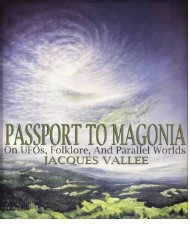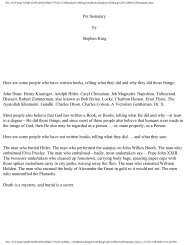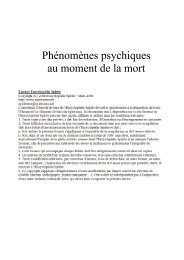extraordinary%20encounters
extraordinary%20encounters
extraordinary%20encounters
Create successful ePaper yourself
Turn your PDF publications into a flip-book with our unique Google optimized e-Paper software.
Albert K. Bender’s sketch of one of the three “men in black”<br />
who visited his Connecticut house in September 1953 and<br />
gave him the solution to the UFO mystery (Fortean Picture<br />
Library)<br />
eventually wrote Flying Saucers and the Three<br />
Men (1962) for Barker’s small publishing<br />
company. In what nearly all readers saw as an<br />
amateurish science-fiction novel passing itself<br />
off as factual, Bender identified the three men<br />
as space people who abducted him to Antarctica,<br />
where Bender met monstrous beings at<br />
an alien base.<br />
The dismal reception afforded Bender’s<br />
book would likely have ended MIB talk if not<br />
for the emergence in the latter 1960s of John<br />
A. Keel, who coined the term “MIB.” Keel, a<br />
freelance writer living in New York City, secured<br />
a generous book contract from a major<br />
New York publisher to write what was intended<br />
to be the definitive work on UFOs. An<br />
occult theorist strongly attracted to demonology,<br />
Keel held UFOs and their occupants<br />
to be shape-shifting entities from a sinister<br />
otherworld. Among their agents were<br />
MIB who, in common with their brethren,<br />
Men in black 171<br />
sought to confuse, manipulate, and even destroy<br />
those who encountered them or sought<br />
to uncover the truth about them. Keel collected<br />
MIB reports from several states and further<br />
claimed that he had interacted with them<br />
personally. In Keel’s view, MIB have played a<br />
behind-the-scenes role in much of human history<br />
and belief.<br />
For the most part, Keel’s MIB could not<br />
have passed easily for human. They were darkfeatured<br />
(or, conversely, unnaturally pale),<br />
bug-eyed, and confused; and their behavior<br />
betrayed their unfamiliarity with the earthly<br />
environment and social customs. For some<br />
reason, they usually drove black limousines,<br />
frequently Cadillacs.<br />
Other investigators collected similar re p o rt s<br />
f rom around the world. Some suggested that<br />
the MIB we re government or military operat<br />
i ves, others that they we re aliens. By 1966,<br />
e ven the U.S. Air Fo rce was hearing of such incidents<br />
and tried to run them down, without<br />
success. Colonel George P. Freeman, a Pe n t agon<br />
spokesman for the U.S. Air Fo rc e’s UFOi<br />
n vestigating Project Blue Book, complained,<br />
“We have n’t been able to find out anything<br />
about these men” (Keel, 1975). In the 1990s,<br />
ufologist William L. Mo o re would allege,<br />
though without providing substantiating evidence,<br />
that “Men in Black are really gove r nment<br />
people in disguise . . . members of a<br />
rather bizarre unit of Air Fo rce intelligence<br />
k n own currently as the Air Fo rce Special Activities<br />
Center (AFSAC)” (Mo o re, 1993).<br />
In recent years, Jenny Randles, a wellregarded<br />
English ufologist, has looked into<br />
MIB cases in Britain. In her view, some are<br />
genuinely puzzling, sometimes involving witnesses<br />
who have never heard of the phenomenon<br />
yet describe many of its classic features.<br />
From interviews and official documents, Randles<br />
was led to the conclusion that a secret department<br />
of the Ministry of Defense was<br />
monitoring certain kinds of UFO reports.<br />
See Also: Kazik; Keel, John Alva<br />
Further Reading<br />
Barker, Gray, 1956. They Knew Too Much about Fly -<br />
ing Saucers. New York: University Books.





